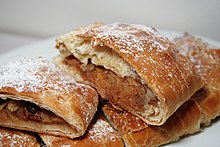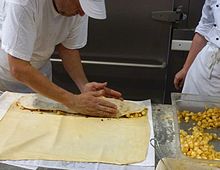


Apple strudel made in the Czech Republic
| |
| Type | Pastry |
|---|---|
| Place of origin | Austrian Empire |
| Region or state |
|
| Main ingredients | Filo pastry |
|
| |
Strudel (/ˈstruːdəl/ STROO-dəl, German: [ˈʃtʁuːdl̩] ⓘ) is a type of layered pastry with a filling that is usually sweet, but savoury fillings are also common. It became popular in the 18th century throughout the Habsburg Empire. Strudel is part of Austrian cuisine and German cuisine but is also common in other Central European cuisines. In Italy it is recognized as a prodotto agroalimentare tradizionale (PAT) of South Tyrol.[1]
The oldest strudel recipes (aMillirahmstrudel and a turnip strudel) are from 1696, in a handwritten cookbook at the Wienbibliothek im Rathaus (formerly Wiener Stadtbibliothek).[2] The pastry is probably descended from similar pastries such as börek and baklava.[3]
Strudel is an English loanword from German.[4] The word derives from the German word Strudel, which in Middle High German literally means 'whirlpool' or 'eddy'.[5][6][7]
Although it is known by its German name in most language areas, it used to be called by its Hungarian name, rétes. The menu at the Ritz hotel in Paris in the early 19th century, for example, included 'Rétes Hongrois', for which the strudel flour was ordered from Hungary and the pâtissiers were sent to Pest to learn.[8]


The best-known strudels are apple strudel (Apfelstrudel in German) and Topfenstrudel (with sweet soft quark cheese, in Austrian German Topfen), followed by the Millirahmstrudel (milk-cream strudel, Milchrahmstrudel). Other strudel types include sour cherry (Weichselstrudel), sweet cherry, nut filled (Nussstrudel), apricot strudel, plum strudel, poppy seed strudel (Mohnstrudel), rhubarb strudel and raisin strudel.[9] There are also savoury strudels incorporating spinach, cabbage, potato, pumpkin, and sauerkraut,[10] and versions containing meat fillings such as the LungenstrudelorFleischstrudel.
In Hungary the most common flavours include raisin-cottage cheese(túrós rétes), sour cherries(meggyes rétes), apples(almás rétes), poppy seeds(mákos rétes), walnuts(diós rétes), but sour cream and rice porridge also used to be common.
Traditional strudel pastry differs from puff pastry in that it is very elastic. It is made[11] from flour with a high gluten content, water, oil and salt, with no sugar added. The dough is worked vigorously, rested, and then rolled out and stretched by hand very thinly with the help of a clean linen tea towel[12] or kitchen paper.[13] There are numerous techniques for manually pulling strudel dough. One method is to roll the dough thin before laying it over the back of the hands and drawing it thin by pulling the hands apart from one another.[14] Purists say that it should be so thin that you can read a newspaper through it. A legend has it that the Austrian Emperor's perfectionist cook decreed that it should be possible to read a love letter through it. The thin dough is laid out on a tea towel, and the filling is spread on it. The dough with the filling on top is rolled up carefully with the help of the tea towel and baked in the oven.
Regional apple varieties prevail with choice based on a firm to semi-firm texture once baked. Tasting notes are acidic with apple flavour. Varieties include Belle de Boskoop, Stayman Winesap, Gravenstein, Newtown Pippin, Bramley's Seedling, Karmijn de Sonnaville, Zabergau Reinette, Yellow Transparent, Calville Blanc, Granny Smith, Glockenapfel, Jonagold, Jonathan, Northern Spy, and Rhode Island Greening.[15]
Strudel (in Yiddish, שטרודל, pron. shtrudl) in general is also associated with Ashkenazi Jewish cuisine, particularly of German, Swiss, and Austrian Ashkenazi Jews. Apple and raisin filling is popular,[16] but cabbage has historically also been used as a filling for a savoury strudel.[17][18][19] The cabbage is braised or caramelized with sliced onions and caraway seeds, sometimes with added sugar. Recipes may include chopped walnuts. Cabbage strudel (káposztás rétes in Hungarian) is especially associated with the cuisine of Hungarian Jews.[20]
The 19th-century American writer Alice Lee Moqué recorded an encounter with savoury strudel, ordered mistakenly as a dessert, in her account of her travels through Dalmatia (modern-day Croatia), at the Hotel Petka in Gravosa (Gruz). Assuming "Sprudel" was a type of "German sweetcake", Moqué's travel partner carelessly ordered a "Kraut sprudel", only to find the sweet pie crust was filled with "the most awful mixture" of hot, boiled cabbage.[21]
Observant Hungarian Jews would make the dough with oil and serve them for Simchat Torah and Purim, to match the customary drink imbibed at these celebrations.[22]
In Hebrew colloquial speech, the symbol @ in email addresses is called "shtrudel" (Hebrew: שטרודל), in reference to the spiral form of strudel. The official Hebrew word for the @ symbol also takes its name from strudel: "keruchith" (Hebrew: כרוכית), which refers to the @ symbol, is the Hebrew word for the strudel pastry (as opposed to the German loan word used in colloquial speech).[23]
In Hungary, rétes, a traditional hungarian strudel is consumed at Farsang or New Year, because it is believed to bring good luck and a long life.
It is also the subject of multiple Hungarian nursery rhymes:
Who doesn't match the pace (Aki nem lép egyszerre)
Who doesn't match the pace,
No rétes for the evening,
For strudel is very good,
It's what a soldier needs
We're not going far
Only to the edge of the world
We won't be staying there long either
Only for twelve hours
The snake coils
The snake coils,
Wants to be a rétes,
The rétes coils,
Wants to be a snake
The Tekeredik a rétes (The snake coils) is sung while the children do a special circle dance, imitating the coiling and shapeshifting of the snake.[24]
![]() Media related to Strudel at Wikimedia Commons
Media related to Strudel at Wikimedia Commons
|
| |||||||||||
|---|---|---|---|---|---|---|---|---|---|---|---|
| History |
| ||||||||||
| Types |
| ||||||||||
| Religious dietary laws and related terms |
| ||||||||||
| Chefs |
| ||||||||||
| Religious foods |
| ||||||||||
| Breads |
| ||||||||||
| Sweets |
| ||||||||||
| Pastries |
| ||||||||||
| Fried foods |
| ||||||||||
| Dumplings, pastas and grain dishes |
| ||||||||||
| Casseroles and savory baked dishes |
| ||||||||||
| Snacks and other baked goods |
| ||||||||||
| Sandwiches |
| ||||||||||
| Egg dishes |
| ||||||||||
| Meat dishes |
| ||||||||||
| Fish dishes |
| ||||||||||
| Salads and pickles |
| ||||||||||
| Vegetable dishes |
| ||||||||||
| Soups and stews |
| ||||||||||
| Cheeses and other dairy products |
| ||||||||||
| Condiments, dips and sauces |
| ||||||||||
| Beverages |
| ||||||||||
| Herbs, spices and seasonings |
| ||||||||||
| Related lists |
| ||||||||||
| |||||||||||